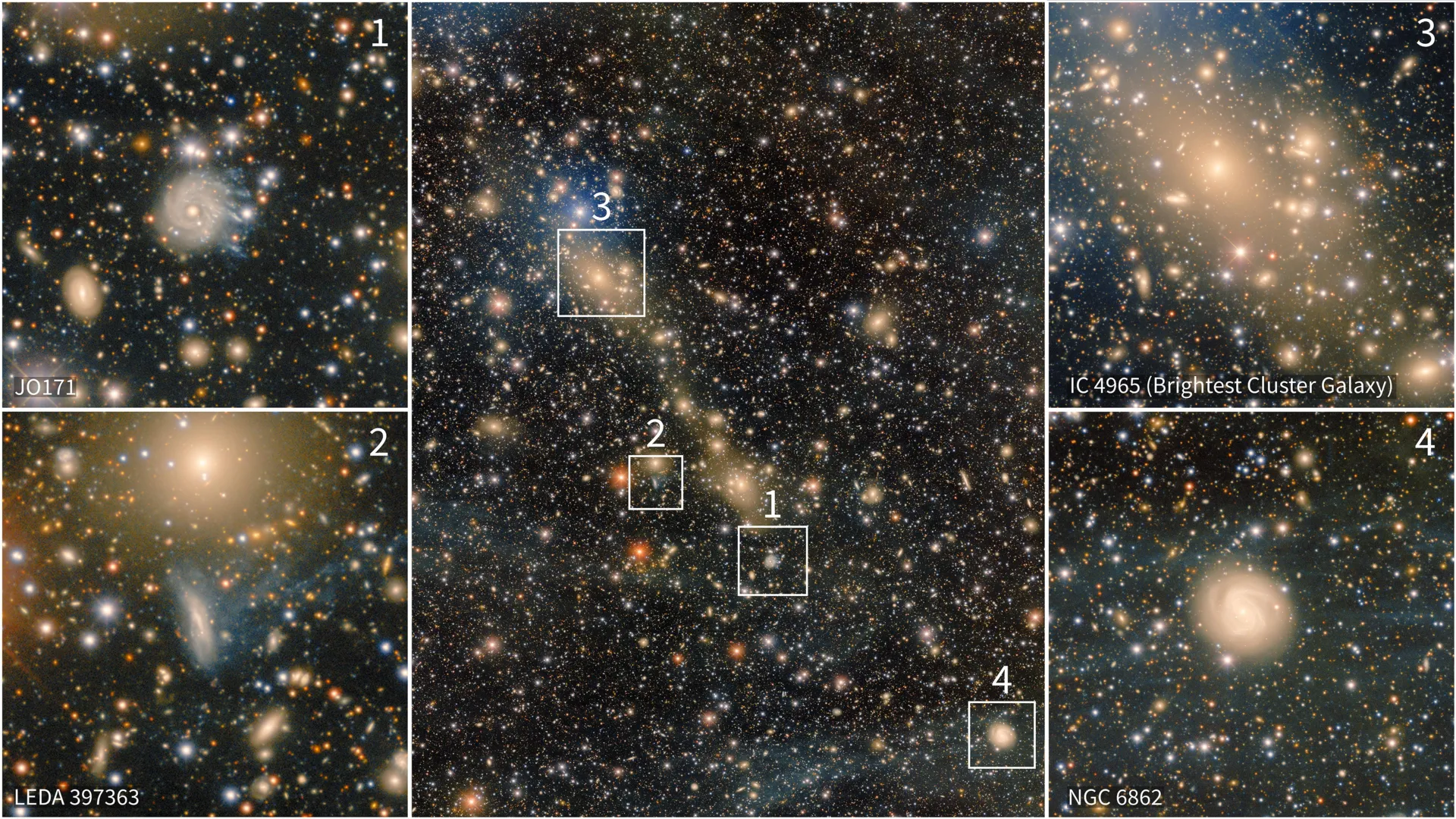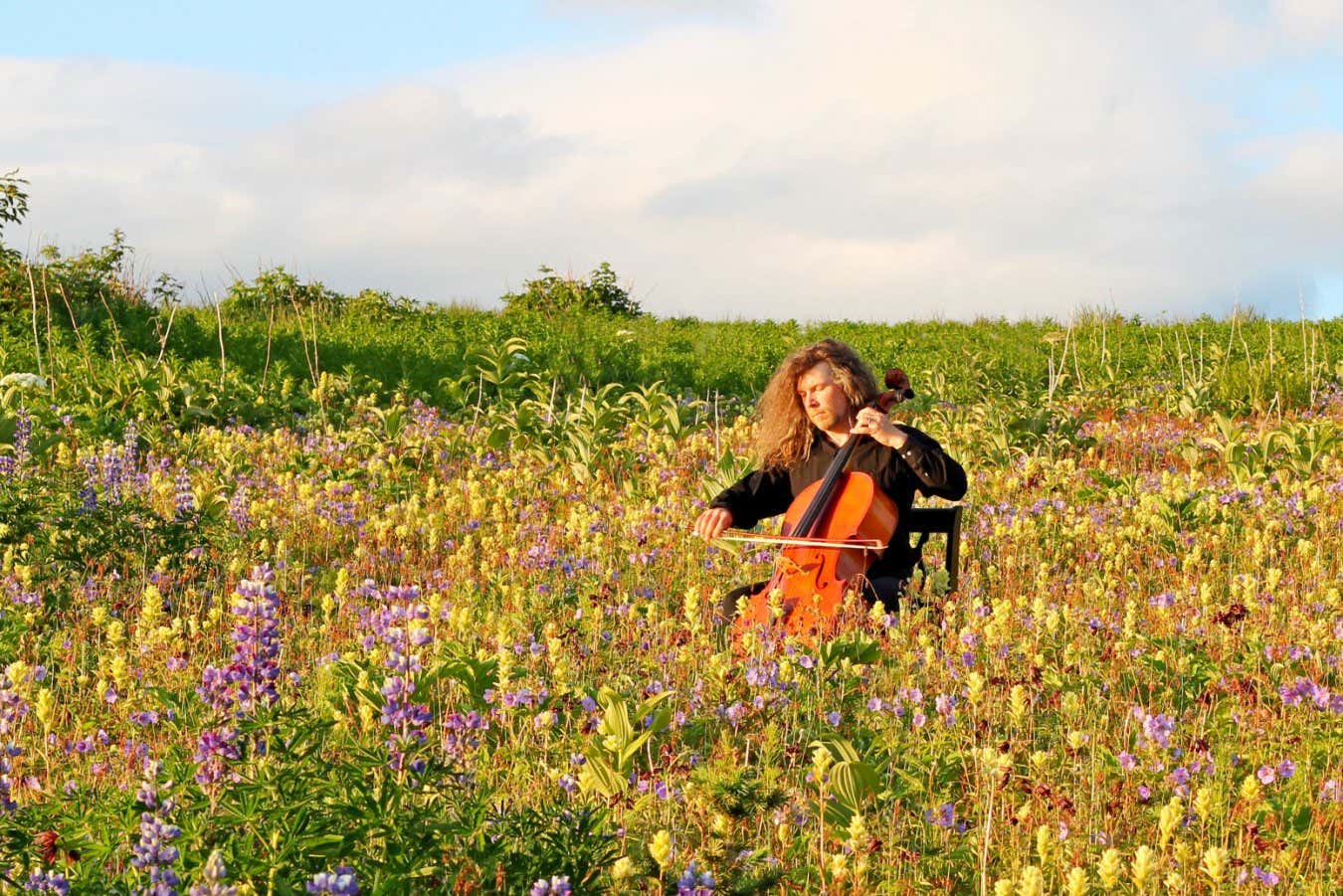Using one of the most detailed sets of observations ever of a galaxy cluster 700 million light-years from Earth, astronomers have captured the faint glow of stray stars in the process of being ripped from their home galaxy and absorbed into another. The ‘bridge’ of diffuse light — spanning roughly a million light years between two galaxies in the cluster Abell 3667 — is the first direct evidence that the two brightest galaxies in the cluster are actively merging.
The findings also imply, the researchers say, that Abell 3667 formed from two smaller clusters, which had themselves merged around a billion years ago.
“This is the first time a feature of this scale and size has been found in a local galaxy cluster,” said Anthony Englert, a Ph.D. candidate at Brown University and lead author of a study describing the findings. “We knew that it was possible for a bridge like this to form between two galaxies, but it hadn’t been documented anywhere before now. It was a huge surprise that we were able to image such a faint feature.”
The new images of Abell 3667 were made using the Dark Energy Camera (DECam) mounted on the Víctor M. Blanco Telescope at Cerro Tololo Inter-American Observatory in Chile. Englert and two colleagues — Ian Dell’Antonio, a professor of physics at Brown, and Mireia Montes, a research fellow at the Institute of Space Sciences in Barcelona, Spain — stitched together a record-breaking 28 hours of observations taken over a span of years by DECam. The findings are published in The Astrophysical Journal.
“Because Blanco has been imaging with DECam for the past decade, there is a ton of archival data available,” Englert said. “It was just a happy coincidence that so many people had imaged Abell 3667 over the years, and we were able to stack all of those observations together.”
That extensive observation time is what made it possible to image the dim light of stray stars within the cluster. This type of diffuse light, known as intracluster light or ICL, offers a treasure trove of information about the history of Abell 3667 and the gravitational dance of the galaxies within it.
The ICL imaged by Englert and his colleagues revealed a special type of galactic merger happening in Abell 3667. Normally, Englert says, mergers that involve the largest galaxy in a cluster, called the brightest cluster galaxy or BCG, occur gradually as it steals stars from many smaller galaxies that surround it. But this new research shows something different happening in this case. Abell 3667 is actually made of two galaxy clusters, each with its own BCG, that are now merging together. The ICL bridge discovered by the researchers suggests that the larger BCG is stealing stars from the smaller one — an event known as a rapid or aggressive merger. As the two BCGs merge, so too do the smaller galaxies that surround them, making Abell 3667 the product of two merging clusters. Data from X-ray and radio frequency observations had suggested a rapid merger in Abell 3667, but this is the first optical evidence to back it up.
The appearance of intracluster light in these new images offers a tantalizing preview of what’s to come when the Vera C. Rubin Observatory becomes fully operational later this year or early next. Using a telescope twice the size of Blanco and the largest camera ever built, the Rubin telescope will perform a 10-year scan deep into the entire southern sky, a project called the Legacy Survey of Space and Time.
“Rubin is going to be able to image ICL in much the same way as we did here, but it’s going to do it for every single local galaxy cluster in the southern sky,” Englert said. “What we did is just a small sliver of what Rubin is going to be able to do. It’s really going to blow the study of the ICL wide open.”
That will be a scientific bonanza for astronomers and astrophysicists. In addition to revealing the history of galaxy clusters, the ICL holds clues to some of the most fundamental mysteries of the universe, particularly dark matter — the mysterious, invisible stuff thought to account for most of the universe’s mass.
“ICL is quite important for cosmology,” Dell’Antonio said. “The distribution of this light should mirror the distribution of dark matter, so it provides an indirect way to ‘see’ the dark matter.”
Seeing the unseeable — that’s a powerful telescope.
The Victor M. Blanco Telescope and the Vera C. Rubin Observatory are operated by NOIRLab, the U.S. national center for ground-based, nighttime optical astronomy operated by the National Science Foundation. The research was funded by NSF (AST-2108287), the U.S. Department of Energy (DE-SC-0010010) and the NASA Rhode Island Space Grant Consortium.
Image Details
- Jellyfish galaxy JO171
Similar to the iconic Hoag’s Object, JO171 is an example of a ring galaxy, characterized by a completely detached ring of young stars surrounding a central old spheroid. JO171’s fall into the dense Abell 3667 galaxy cluster is stripping it of gas, creating the striking jellyfish-like tendrils seen trailing off to one side of the galaxy. Analysis of the galaxy’s stellar population and its gas and stellar dynamics shows that the origin of the ring is related to an interaction with another galaxy in the distant past, prior to its accretion onto Abell 3667. More recently, since infall into the cluster, the gas in the ring has been stripped by ram pressure, causing the quenching of star formation in the stripped half of the ring. This is the first observed case of ram-pressure stripping in action in a ring galaxy. Both of the events (accretion and stripping) caused dramatic transformations in this galaxy. - Jellyfish galaxy LEDA 64246
LEDA 64246 is another example of extended galaxy tails formed by ram-pressure stripping. Their blue glow indicates that the stripping has triggered star formation in the trails. - Brightest cluster galaxy IC 4965 and infalling group
The central galaxy in this cutout is referred to as the brightest cluster galaxy (BCG). The formation of BCGs has been an astronomical mystery for decades. The mystery has been partially answered by the detection of intracluster light, which provides evidence that BCGs generally form through the gradual stripping of stars from less massive galaxies in the cluster, which then accrete onto the BCG. - NGC 6862
NGC 6862 is a Seyfert galaxy that is partially obscured by Milky Way cirrus, or integrated flux nebulae.







